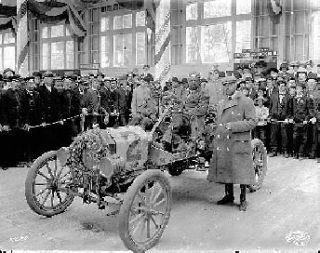History will roll into Meadowbrook Farm Friday, July 10, when 55 vintage Model T Fords arrive during the final leg of a nearly 3,900-mile transcontinental race.
The cars left White Plains, New York, on June 13 to reenact a 1909 race from New York City’s city hall to the Alaska-Pacific-Yukon Exposition in Seattle.
The cars will be on display and drivers available to talk at Meadowbrook Farm between Snoqualmie and North Bend from noon to 2 p.m.
This is the third time the race has been re-enacted. Other recreations of the race happened in 1959, 50 years, and 1984, 75 years, after the original run.
1909 run
In the original run, five automobiles entered the race. Two of the five were Fords.
“Henry Ford was really trying to push the fact that everybody should be able to afford a car,” said Snoqualmie historian Dave Battey.
Cars in those days had incredibly flexible frames and high clearance, being built to run on rutted horse roads.
There were no paved roads in the Snoqualmie Valley at the time, and Snoqualmie Pass was virtually impassable due to snow. One of the original Model T competitors had to be dug out of the snow on the pass by a railroad crew.
Local accounts by Dio Reinig, a Snoqualmie farmer and businessman, tell how he helped get one of the race cars out of a local ditch.
“One night about midnight, my uncle drove in from Aberdeen,” Reinig stated. “He said that he had seen a New York car in the ditch below the Meadowbrook bridge, and that they wanted help as they were in a race to Seattle.”
Reinig and his uncle went into town and roused the livery stable keeper, who brought a team of horses and plenty of tackle.
“We soon had the car on its way,” Reinig stated. “The car was one of the best makes at that time, a Shawmut with forty-inch wheels. The driver said he had New York air in one tire, which was certainly unusual for that time.”
One of Ford’s Model Ts reached the finish line first, after 22 days on the road. Henry Ford was at the finish line in Seattle at the exposition’s Drumheller Fountain, which still stands on the University of Washington’s campus.
It was the first year of the Model T’s production, and Ford used the race to market the car. Over 15 million were produced before it was discontinued in 1927.
However, according to Reinig’s account, the prize was taken away a few months later and given to a Shawmut car — probably the same car that got stuck in Snoqualmie. Ford’s team had violated the competition guidelines.
“His ‘winning’ car did not really win,” Battey said. The crew changed its engine mid-race in Idaho, which was against the rules.
Ford got a tremendous amount of publicity out of the race, though.
“This was a very big race,” Battey said. “He was a genius with mechanics and a genius with publicity. He used it so well that everybody will thinks a Ford won.”
50 years ago
According to the June 18, 1959 , edition of the Snoqualmie Valley Record, the 50-year reenactment “followed a route carefully charted to duplicate as closely as possible the course of horse-and-buggy roads and trails used 50 years ago for the transcontinetal contest.
The Record story of 1959 marks how the rerun lacked the trials and hardships of the first run, but not its color. Included in the caravan was a replica of the winning 1909 racer as well as a model of a futuristic ‘Levacar,’ meant to run on a film of air without wheels.
This year’s reenactment, the Centennial Run, follows the original course as much as possible, including a trip across Snoqualmie Pass.
The Pony Boy All-Star Big Band and Snoqualmie Tribe Canoe Family Drum Group will perform separately at the July 10 rally. The event is free.
For more information, visit www.cityofsnoqualmie.org or call (425) 749-6905. The race can be followed at oceantoocean.ning.com. To learn about the Alaska-Pacific-Yukon Exposition Centennial celebration, visit www.ayp100.org.



